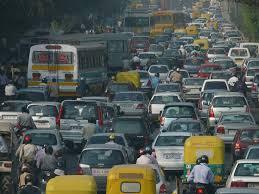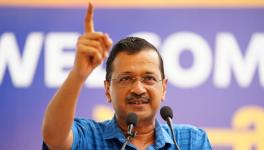Urban Air Pollution: Will Delhi Even Out the Odds?
The short and temporary experiment in Delhi to combat severe air pollution by rationing road-use by personal 4-wheeled vehicles on alternate days, corresponding to odd or even numbered dates and license plates, is to end this weekend. The media especially newspapers, who for once have taken good advantage of their greater ability than TV for in-depth coverage, have been full of analysis of whether the odd-even formula has worked or not. A vast amount of commentary has been generated using real-time air pollution readings in Delhi by different agencies, various reports especially the much quoted one from IIT Kanpur, scattered reports of road traffic density and ridership on Delhi’s metro and bus services, random expert opinions on seasonal variations, temperature profiles and wind patterns, and all manner of interpretation ranging from the erudite to the frankly amateurish and speculative, leaving everyone quite confused.
Has air quality actually improved in the second week of the trial, or was the over 50 percent drop due to warmer temperatures and fresh winds? Do some trends showing lower pollution peaks this year compared to last year tell us more about the weather than about odd-and-even?

Image Courtesy: en.wikipedia.org
Comments have covered the whole gamut of possible arguments. The negatively biased seemed determined to reject any arguments of possible benefits from this policy, which constantly pointed to pollution sources other than vehicles and gave heavy spin to all data or information. The Delhi Government led by the Aam Aadmi Party (AAP) which took the bold gamble of the odd-even policy, could see no wrong and spun all information the other way! The AAP government did itself no favours by not making the IIT Kanpur study public and by cherry-picking data to suit its own arguments. The BJP did not oppose the policy as such, but kept running it down through a virulent social media campaign, taking pot shots at every opportunity.
Even the judiciary was not far behind, on both sides of the debate! In a related petition by the automobile industry arguing against the ban on sale of diesel-engined personal vehicles above 2000cc, a judge caustically asked whether their vehicles emitted oxygen! And in the Delhi High Court, a bench queried the Delhi government to explain why it was not considering the inconvenience caused to so many people, perhaps forgetting that it was the “inconvenience” of hundreds of thousands of pollution-related deaths and ailments from cancer and respiratory problems that had brought the issue of persistent, high and worsening air pollution in Delhi to the forefront of public concern.
Policy-making
All in all, not a very good lesson in how public policy should be formulated which should have been based in science and evidence-based reasoning, not emotions, innuendo and bias including by those wittingly or unwittingly influenced by special interests.
On their part, the people of Delhi responded with the seriousness the issue deserved, took it upon themselves to comply with the odd-even rule with enthusiasm and to an unexpected extent. Car owners took to car-pooling, to the Metro and buses, leading to perceptible reduction of traffic congestion and time taken on vehicular trips. People of the capital had confounded the widespread scepticism expressed prior to the odd-even policy taking effect as to how it would be received by a notoriously cynical and lawless Delhi citizenry. While one may debate how much air pollution was actually reduced, or whether personal vehicles are indeed a major cause, people of Delhi have undoubtedly shown whey take the issue of air pollution seriously, recognize the harm it is doing, and are more than willing to contribute to mitigation even at considerable pain to themselves. This augurs well for the future.
What now?
The Delhi government has all along maintained that, as has been the practice in other countries too when similar road-use rationing has been introduced, the odd-even rule was introduced as a short-term emergency measure to counter an emergent situation during the winter when air pollution in Delhi always peaks. So will this effort at cleaning up Delhi’s air end with this experiment, or will it continue and confront the problem? Despite all the confusion caused by the incoherent debate so far, one thing that has emerged clearly is that urban air pollution in Delhi and elsewhere in India is multi-dimensional, and calls for an integrated and long-term approach, keeping in mind the interests of all sections of urban residents. This calls for far greater clarity than exists now as regards the major sources of different pollutants, the technical, socio-economic and policy dimensions underlying the pollution, the measures required to tackle the pollution and how they should be implemented.
These questions are important, if not crucial, and not just for Delhi either. While the capital has grabbed headlines internationally for having the world’s highest air pollution, other cities in India are not far behind. Not just the metropolitan centres either. Many state capitals, and Tier-2 and Tier-3 cities and towns, are not much better, and are likely to reach or even surpass Delhi levels in the not too distant future.
While it is far beyond the scope of this article to examine all aspects in detail, some of the major aspects involved are dealt with briefly, so as to enable the reader to move back and look at the larger picture and bring at least some pointers to policy directions.
Sources of air pollution
Much of the debate has focused on the major sources of air pollution in Delhi, prompted by the many previous studies and reports which have pointed in different directions, such as to coal-fired power plants, to industry (based on which huge swathes of industry were shunted out of Delhi to its periphery) and to vehicles, lately to diesel vehicles in particular. Whereas an exhaustive assessment of the available information is not possible here, some perspective is nevertheless required.
The IIT Kanpur study conducted over a two-year period looking at sources, seasonal variations and geographical distribution, and which has formed the basis for a large amount of media commentary, has perhaps not been read or understood properly.
Several commentators have used the IIT report to argue that vehicular pollution is not at all as serious a problem as is being made out, which was after all why the odd-even rule was introduced and applied chiefly to 4-wheered personal vehicles, and that even if the policy did have a positive impact it would only bring down pollution levels by a small if not tiny percentage.
The IIT study indeed points to road dust as the major source of particulates which, in turn, are the major pollutants in Delhi. But the picture is more complex than the oft-cited figure of 56 percent for road dust with vehicles trailing far behind. The study in fact brings out that while this high figure for dust holds for PM10 (particles of 10 microns or less) in the winter months, in PM 2.5 it drops to 38 percent while vehicles contribute as much as 20 percent and become a dominant pollutants source in winters. The Report adds that, in fact, other gaseous pollutants such as nitrogen dioxides (NOx) predominantly from power plants, industrial point sources and vehicles, and sulphur oxides (SOx) predominantly from power plants, react with other air-borne substances to produce what are known as secondary particles which add substantially to particulate pollutants especially PM 2.5. (NOx also reacts to produce surface-level ozone, a deadly pollutant extremely harmful to human health). The study found that across different locations in Delhi and across seasons, the most consistent pattern in Delhi’s air pollution is high-levels of secondary and vehicular PM10 and PM 2.5 pollutants. In contrast, road dust shows somewhat similar consistency only in PM 10, that too in summer.
One also needs to look beyond particulates, contrary to some commentators who speak only about particulates and refer to it co-terminously with air pollution.
In fact, NOx emissions from vehicles, especially with diesel engines, have deadly consequences. NO2 is a highly toxic gas and is extremely harmful to air passageways. 36 percent of NOx comes from vehicles at ground level and clearly have greater effect than the 52 percent NOx from power plants and industry which emanate from stacks over 100 feet above the ground. Total emission load of NOx pollutants is also higher than the particulate load.
Toxic vehicular pollutants
Point here is not that road dust is not a major pollutant, or that particulates are not important. But it would be a grave mistake to minimize the danger posed by vehicles, especially from diesel. Some critics have argued that the IIT study has pointed to diesel trucks as the major source of NOx rather than personal vehicles but this is short-sighted. If plying of trucks within Delhi is minimized or otherwise regulated, it would certainly help, especially in diesel to Euro-VI (Bharat Stage VI) standards is actually made available throughout India by 2019 as promised, but the rapid “dieselization” of the passenger car fleet in India, notably in Delhi, also needs to be controlled, especially because diesel was never intended to be used for personal vehicles in India.
Those who point to the large and continuing use of diesel-engined vehicles in Europe as an indication that we have got it wrong in India, are in fact convenient turning away from the reality.
The very reason that Volkswagen resorted to the “cheat device,” or software that turned off pollution-control mechanisms except under test conditions which it could sense by engine behaviour, was that even its most advanced technology could not maintain emissions to prevalent Euro-VI or equivalent US standards under normal road conditions.
British policy makers and the general public were taken aback last year by a King’s College, London, study for the Greater London Authority and Transport for London, which showed that air pollution in London was far exceeding EU standards for some deadly pollutants and, furthermore, that this trend did not look like abating any time soon. The Courts were moved sufficiently to call upon the Government to come up with an action plan by this year. The culprit? NO2 ascribed to diesel vehicles! And now recognized as being even more deadly than PM 2.5 and held responsible for the spike in pollution-related deaths in London which has now breached 9,500 a year, with “only” 3,500 attributed to particulates.
Policy pointers
While the IIT Kanpur study present a large amount of data, it disappoints in its policy recommendations according to which Delhi would be lucky if it managed to reduce particulate air pollution by 50 percent even in the next decade. The study offers a wide range series of recommendations but, sadly, most are of a technical nature rather than being rooted in a more structural and holistic approach.
For instance, as regards, vehicular emissions, the study prescribes earlier shifting to BS-IV norms to 2019 as against the earlier 2020, retro-fitting of particulate filters in diesel vehicles, change of technology in 2-wheelers. These measures should indeed be taken, and there is no reason for the automobile industry in India to claim high costs or lack of capability when most of which is in any case run by international majors with access to the most advanced technologies. But one would have thought reducing the numbers of vehicles on the capital’s roads would be effective too!
Why should Delhi have so many personal vehicles as a proportion of its population? Why has all the urban planning in Delhi got so car-centred that even two-wheelers have little room to move about, forget about cyclists and pedestrians who do not seem to count for anything? Delhi has more road-length per capita that any comparable city in the world, European capitals not excluded?
The odd-even experiment showed that, if alternatives are available, people would leave their cars at home. Convenient public transport with good last-mile connectivity is a must and can contribute to sharply reducing personal vehicle use, both 4-wheelers and 2-wheelers whose exemption from the odd-even scheme remains a mystery, unless the Delhi government felt the existing public transport system could not stand the strain. The Metro has been great for commuters in Delhi, but even its rickety bus service carries more passengers daily. Even with the planned extension of the Metro from the present 140km to over 400km rail length, Delhi needs at least 5,000 more buses on better planned routes. Unfortunately, most State capitals leave alone other cities and towns, do not have any viable bus transport system at all, leaving commuters to the mercies of random ramshackle private buses and the ubiquitous “Vicky’s,” perhaps the most polluting vehicles on the roads.
Among vehicles, buses and trucks are more easily handled. But dust is indeed a major problem, especially with rampant building construction activity with minimum regulation and even more lax enforcement.
Road dust is certainly a major issue. Especially with the universal practice, certainly in Delhi, of leaving large unpaved strips on either side of all roads, a continuous source of pollution, exacerbated by huge vehicular traffic. Delhi is also perhaps the only “world class” city, even in India, whose municipal authorities sweep the streets at peak school or office-going hours rather than two or three hours earlier! The Delhi government is apparently planning to implement one of the IIT study’s recommendations, to vacuum trunk roads at least twice a week and is soon to float tenders. Might it not make more sense to pave the streets completely and wash them, but that would raise the issue of water scarcity and of blocking off pathways for rainwater to recharge underground aquifers. Water run-off could always be led down storm-water drains to recharge points at appropriately close intervals, and recycled “grey” water could be used for road-cleaning.
Integrated thinking, anyone?
Disclaimer: The views expressed here are the author's personal views, and do not necessarily represent the views of Newsclick
Get the latest reports & analysis with people's perspective on Protests, movements & deep analytical videos, discussions of the current affairs in your Telegram app. Subscribe to NewsClick's Telegram channel & get Real-Time updates on stories, as they get published on our website.
























